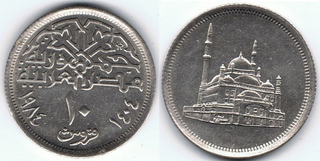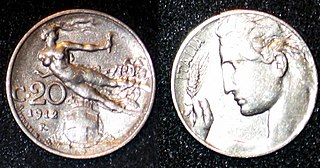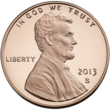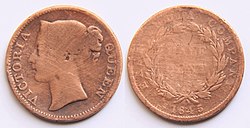
Centime is French for "cent", and is used in English as the name of the fraction currency in several Francophone countries.

The peseta was the currency of Spain between 1868 and 2002. Along with the French franc, it was also a de facto currency used in Andorra.
Decimalisation or decimalization is the conversion of a system of currency or of weights and measures to units related by powers of 10.

The Philippine peso, also referred to by its Filipino name piso, is the official currency of the Philippines. It is subdivided into 100 sentimo, also called centavos.

The piastre or piaster is any of a number of units of currency. The term originates from the Italian for "thin metal plate". The name was applied to Spanish and Hispanic American pieces of eight, or pesos, by Venetian traders in the Levant in the 16th century.

The birr is the primary unit of currency in Ethiopia. It is subdivided into 100 santims.
The centavo is a fractional monetary unit that represents one hundredth of a basic monetary unit in many countries around the world. The term comes from Latin centum, with the added suffix -avo ('portion').
Several linguistic issues have arisen in relation to the spelling of the words euro and cent in the many languages of the member states of the European Union, as well as in relation to grammar and the formation of plurals.

Philippine peso coins are issued by the Bangko Sentral ng Pilipinas for circulation in the Philippines and are currently available in seven denominations. The Philippine peso has been in use since Spanish rule.

Peso dominicano has been the name of the currency of the Dominican Republic since 2010. Its symbol is "$", with "RD$" used when distinction from other pesos is required; its ISO 4217 code is "DOP". Each peso is divided into 100 centavos ("cents"), for which the ¢ symbol is used. With exception of the United States dollar, it is the only currency that is legal tender in the Dominican Republic for all monetary transactions, whether public or private.
The colón is the currency of Costa Rica. It was named after Christopher Columbus, known as Cristóbal Colón in Spanish. A colón is divided into one hundred céntimos.
The colón was the currency of El Salvador from 1892 until 2001, when it was replaced by the U.S. dollar during the presidency of Francisco Flores. The colón was subdivided into 100 centavos and its ISO 4217 code was SVC. The plural is "colones" in Spanish and the currency was named after Christopher Columbus, known as Cristóbal Colón in Spanish.

The dollar sign, also known as peso sign, is a currency symbol consisting of a capital ⟨S⟩ crossed with one or two vertical strokes, used to indicate the unit of various currencies around the world, including most currencies denominated "peso" and "dollar". The explicitly double-barred sign is called cifrão in the Portuguese language.
Each "article" in this category is a collection of entries about several stamp issuers, presented in alphabetical order. The entries are formulated on the micro model and so provide summary information about all known issuers.

Centesimo is a currency unit equivalent to cent, derived from the Latin centesimus meaning "hundredth". In Italy it was the 1⁄100 division of the Italian lira.

The venezolano was the currency of Venezuela between 1872 and 1879. It was divided into 100 centavos, although the names céntimo and centésimo were also used. Venezolano was also the name of two currencies planned in 1854 and 1865.

The céntimo or cêntimo was a currency unit of Spain, Portugal and their former colonies. The word derived from the Latin centimus meaning "hundredth part". The main Spanish currency, before the euro, was the peseta which was divided into 100 céntimos. In Portugal it was the real and later the escudo, until it was also replaced by the euro. In the European community cent is the official name for one hundredth of a euro. However, both céntimo and cêntimo are commonly used to describe the euro cent.

Japanese invasion money, officially known as Southern Development Bank Notes, was currency issued by the Japanese Military Authority, as a replacement for local currency after the conquest of colonies and other states in World War II.

The currency of Venezuela has been in circulation since the end of the 18th century. The present currency unit in Venezuela is the Venezuelan bolívar.














